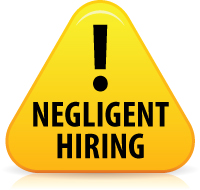 An employer is exposed to risk caused by the conduct of an employee whether or not such conduct is within the course and scope of the employee’s employment. Focusing your organization’s human capital risk mitigation measures on only one of these areas of potential exposure may be hazardous to the financial and reputational health of your organization.
An employer is exposed to risk caused by the conduct of an employee whether or not such conduct is within the course and scope of the employee’s employment. Focusing your organization’s human capital risk mitigation measures on only one of these areas of potential exposure may be hazardous to the financial and reputational health of your organization.
Respondeat Superior
Respondeat superior is a general legal liability doctrine that holds an employer responsible for a negligent act or omission of an employee acting within the course and scope of employment. This is a vicarious theory of liability, meaning there needn’t be a finding of any improper action by the employer. The reasonableness of an employer’s actions (e.g., its hiring, supervision and retention of an employee) is irrelevant and provides no basis for the avoidance of employer liability for the acts of an employee. However, in order for the employer to be found liable the complainant must prove the employee acted within the course and scope of employment.
Course and Scope versus Frolic or Detour
Course and scope requirements are generally met where the plaintiff can prove the employee’s act was either authorized by the employer or be closely enough related to an authorized act that the court should “let the master answer” for the employees conduct as a “cost of doing business.”
A commonly referenced example of a situation in which an employer would likely be found liable for the act of an employee under the respondeat superior doctrine is where an employer provides an employee with a cell phone for use, in part, to call into the office for meetings calls while travelling. While driving a vehicle on the way to the airport for employer business, employee calls into a meeting, becomes distracted and causes a vehicle accident and serious injury. Most courts would find the employer liable for the employees act because this fact pattern would likely meet the “course and scope of employment requirement.”
In contrast, most courts distinguish an employee’s act as a “frolic or detour” where the employee’s act that causes harm or injury is unrelated to the employee’s employment. If the facts of the above example are changed slightly and the employee phone call is instead to his grandmother to let her know he is on his way to her house while in her city on business, most courts would find no employer liability for the injury caused by the employee’s negligence.
Negligent Hiring, Negligent Retention
In contrast, the negligent hiring and retention legal liability doctrine holds that an employer can be held liable for the negligent or intentional act or omission of its employees if an employer’s negligent act or omission was a cause, or contributory cause, of the act or omission of the employee and thereby the injury or harm to the claimant. Whether or not the employee was acting within the course and scope of his employment is irrelevant. However, the complainant must prove that in hiring or retaining the employee; the employer knew, or should have known, the employee was dangerous, unfit, or not qualified, and that foreseeable injury or harm could result.
Dangerous, Unfit or Not Qualified, and Foreseeable Harm
Plaintiff’s counsel will use the employee’s past acts and omissions against the employer to show the employee was dangerous, unfit or not qualified. In this context, it will be argued the employee’s past was prologue and should have been viewed by the employer as such. An employer ignores an employee’s past—not only his criminal record history, but his driving, employment, and educational history, and in appropriate situations even his credit history—at the employer’s peril.
Plaintiff’s counsel will also use the employee’s same past acts and omissions against the employer to show that the harm or injury caused was therefore foreseeable. The foreseeability of harm or injury is highly fact specific, and courts are all over the map with respect to whether any particular employee’s act or omission that caused harm or injury was reasonably foreseeable by an employer. However, most courts agree that if an employee has done a specific wrongful act in the past and the employee does the same or highly similar act again, and the employer knew or reasonably should have known about the prior act, any harm caused by the employee’s more recent act was foreseeable by the employer.
The following scenario is illustrative. An employer hires a home healthcare worker with a past burglary conviction and past for cause employment termination. The employer’s background check is cursory and the felony burglary conviction is therefore missed. The employer does not conduct an employment verification or reference check, and thus does not learn of the past for-cause termination. The employee is placed in the employer’s client’s home as a caregiver, and the employee attempts to rob the household where he has been placed by his employer. The employee is confronted by the wife of the patient during the robbery and he kills her. This scenario is based on the actual facts of a notorious negligent hiring lawsuit with $40M in damages.
Exposed, Exposed
Both types of claims have become hot areas of focus for litigation for the plaintiff’s bar.
In a recent article in a leading plaintiff’s counsel publication, experienced trial attorneys advised their colleagues suing an employer over the injuries caused by the employer’s drivers to focus on any history of prior accidents or driving violations, any lack of experience, and the circumstances surrounding the vehicle accident (where was the driving going to and coming from, what and who was in the employee’s vehicle, etc.) and any lack of training or supervision. This recommended focus encompasses the employee’s past acts and omissions (prior accidents and violations, inexperience), and the employer’s omissions (lack of training and supervision). The former will be relevant to a negligent hiring claim, and the latter to a claim of respondeat superior and general employer negligence.
The ability to defend against both respondeat superior and negligent hiring claims must be part of any risk-averse employer’s human capital risk mitigation strategy. Does an inadequate or outdated human capital risk strategy unnecessarily expose your organization to risk?
Consult the risk management experts at Lowers Risk Group to assess your human capital risk strategy.








